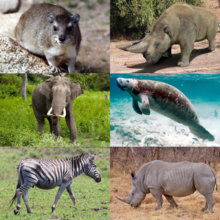| Altungulata | |
|---|---|

| |
| Top: Rock hyrax (Hyracoidea), Arsinoitherium zitteli (Embrithopoda); Middle: Asian elephant (Proboscidea), West Indian manatee (Sirenia); | |
| Scientific classification | |
| Kingdom: | Animalia |
| Phylum: | Chordata |
| Class: | Mammalia |
| Superorder: | Preptotheria |
| (unranked): | Altungulata Prothero & Schoch 1989 Pantomesaxonia Franz 1924 |
| Orders and suborders | |
Altungulata or Pantomesaxonia (sensu Fischer 1986 and later authors) is an invalid clade (mirorder) of ungulate mammals comprising the perissodactyls, hyracoids, and tethytheres (sirenians, proboscideans, and related extinct taxa).
The name "Pantomesaxonia" was originally introduced by Franz 1924, a German zoologist and racial theorist. It was resurrected by Fischer 1986 by including sirenians and excluding South American ungulates, phenacodontids, and meniscotheriids from the original concept.
The name "Altungulata", introduced by Prothero & Schoch 1989 and revised by McKenna & Bell 1997, was erected as an alternative because the updated concept of "Pantomesaxonia" was regarded too deviant from the original concept.
Both names are still in use, and, to add to the confusion, various authors assign different ranks to the involved taxa. For example, according to Thewissen & Domning 1992, Phenacodonta (Phenacodontidae and Meniscotheriidae) and Pantomesaxonia (Sirenia, Desmostylia, Proboscidea, Hyracoidea, and Perissodactyla) are sister groups together making up the superorder Paenungulata.
Altungulata is not supported by molecular evidence unless perissodactyls are excluded (thus dividing Altungulata into Laurasiatheria and Afrotheria), and the validity of the following uniting synapomorphies remain disputed:
- bilophodonty, two lophs or crests running transversally across the crown of the tooth
- large third molars
- molarization of posterior premolars
- elongated thoracic region with at least 19 vertebrae
- clavicle absent
- similar development of fetal membranes
Recent studies on Abdounodus showcase that dental synapomorphies between both groups arose independently, further discrediting the Altungulata hypothesis.
Classification
The classification below is from Rose 2006, p. 242. Paenungulata together with Macroscelidea, Tubulidentata, and the lipotyphlan families Tenrecidae and Chrysochloridae compose Afrotheria. With the exclusion of the better known Radinskya and Minchenella from Phenacolophidae, their affinities to Embrithropoda are suspect, and they were regarded as Altungulata incertae sedis by Mao et al. (2015).
Altungulata Prothero and Schoch 1989
- †Radinskya,
- †Olbitherium
- †Phenacolophidae Zhang 1978
- †Ganolophus Zhang 1979
- †Phenacolophus Matthew and Granger 1925 (= Procoryphodon Flerow 1957)
- †Sanshuilophus Mao et al. 2015
- †Tieshanilophus Tong 1979
- †Yuelophus Zhang 1978
- †Zaisanolophus Gabunia 1998
- Order Perissodactyla
- Suborder Hippomorpha
- Superfamily Equoidea
- Suborder Tapiromorpha
- †Isectolophidae
- Infraorder Ceratomorpha
- Superfamily Tapiroidea
- Superfamily Rhinocerotoidea
- Infraorder †Ancylopoda
- Suborder †Titanotheriomorpha
- Superfamily †Brontotherioidea
- †Brontotheriidae (equoids)
- †Anchilophidae (palaeotheriid equoids?)
- Superfamily †Brontotherioidea
- Suborder Hippomorpha
- Order Paenungulata (=Uranotheria)
- Suborder Hyracoidea (sister taxon of Perissodactyla?)
- Suborder Tethytheria
- Infraorder †Embrithopoda
- Infraorder Sirenia
- Infraorder †Desmostylia
- Infraorder Proboscidea
See also
Notes
- "Mirorder Altungulata". Systema Naturae 2000. Retrieved 5 May 2013.
- ^ Rose 2006, pp. 241–4
- ^ Hooker 2005, pp. 201–2
- "[Bibliography of] Thewissen, Johannes". Sirenia.org. Archived from the original on 2016-03-20. Retrieved 5 May 2013.
- Gheerbrant, Emmanuel; Filippo, Andrea; Schmitt, Arnaud (2016). "Convergence of Afrotherian and Laurasiatherian Ungulate-Like Mammals: First Morphological Evidence from the Paleocene of Morocco". PLOS ONE. 11 (7): e0157556. doi:10.1371/journal.pone.0157556.
- Fang-Yuan Mao, Yuan-Qing Wang, Qian Li & Xun Jin (2015): New records of archaic ungulates from the Lower Eocene of Sanshui Basin, Guangdong, China, Historical Biology: An International Journal of Paleobiology, DOI: 10.1080/08912963.2015.1034120
References
- Fischer, Martin S. (1986). Die Stellung der Schliefer (Hyracoidea) im phylogenetischen System der Eutheria. Courier Forschungsinstitut Senckenberg (in German). Vol. 84. pp. 1–132. ISBN 9783924500214. OCLC 15682192.
- Franz, Victor (1924). Die Geschichte der Organismen. Jena: Verlag G. Fischer.
- Hooker, Jeremy J. (2005). "The phylogenetic, geographic, and temporal origins of the Perissodactyla". In Rose, Kenneth D.; Archibald, J. David (eds.). The Rise of Placental Mammals. JHU Press. ISBN 9780801880223. OCLC 55801049.
- McKenna, Malcolm C.; Bell, Susan K. (1997). Classification of Mammals Above the Species Level. New York: Columbia University Press. ISBN 0231110138. OCLC 37345734.
- Prothero, Donald R.; Schoch, Robert M. (1989). "Origin and Evolution of the Perissodactyla: Summary and Synthesis" (PDF). In Prothero, Donald R.; Schoch, Robert M. (eds.). The Evolution of Perissodactyls. New York: Oxford University Press. pp. 504–37. ISBN 9780195060393. OCLC 19268080. Retrieved 5 May 2013.
- Rose, Kenneth David (2006). The beginning of the age of mammals. Baltimore: JHU Press. ISBN 0801884721.
- Thewissen, J.G.M.; Domning, Daryl Paul (1992). "The role of phenacodontids in the origin of the modern orders of ungulate mammals". Journal of Vertebrate Paleontology. 12 (4): 494–504. doi:10.1080/02724634.1992.10011476. OCLC 4649662166.
| Taxon identifiers | |
|---|---|
| Altungulata | |